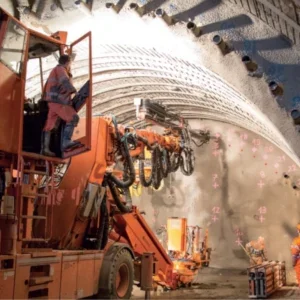HDD is an established and popular method of laying pipelines underground as it can navigate below obstacles, such as roads and rivers, without creating disturbance above ground. This has the added benefits of reducing the environmental impact and the cost.
The technique uses a rig at ground level to launch a pilot bore that drills an arc along an underground trajectory. A reamer is connected to the drill rod at the exit hole and reverses back towards the rig, opening up the bore to create a hole to accommodate the new pipeline.
The pipeline is then connected to the back of a cleaning reamer and it effectively slides into the new path.
The fall in the price of oil, the delayed impact of the global financial crisis and political uncertainty are having some impact on projects requiring HDD but this is merely a pause.
"With the lower oil price and lower energy prices in general, a lot of people are holding back on oil and gas pipelines to see what shakes out," said Dan Billig, EU operations director at Prime Horizontal.
The HDD sector had been rather insulated from the immediate effects of the global financial crisis as in many cases funds were already committed to projects. However, as economies in Europe have been slow to pick up, infrastructure spending is feeling the delayed effects. With the exception of some electricity installations in Germany, and gas works in eastern Europe, the European market has quietened while, in contrast, the UK is fairly steady.
"Out of all the markets in Europe it seems to be the most buoyant," said Billig. "Perhaps people are a bit more confident and are willing to sign off on big projects."
The oil price drop has also affected demand in the US where, over the past few years, shale gas operations had Prime Horizontal busy.
Vermeer UK also reports a boost in demand for drilling equipment in the UK in response to an increase in civil engineering work and the release of projects put on hold during the recession.
"Rigs are now being renewed and upgraded; ancillary equipment such as mixing systems, recycling units and location equipment are also being replaced," said Matthew Izzard, trenchless technology manager at Vermeer UK.
The renewable energy market was a major new market, and contractors were also taking on more challenging projects, such as rock drilling.
"This has pushed us as manufacturers to develop our cutting tool technology and continue to make equipment as cost-effectively as possible," said Izzard.
American Augers, which manufactures big machines of around 100,000lb pull force, has also noticed a slowdown as a result of the oil price.
"Business has generally slowed across the board," said Rob Verwilligen, director of sales and marketing. "Some of it is directly related to the oil price, while in areas like Russia it’s also related to the rising tension with the west."
The European market, which was "not an investment friendly environment" at present, had been quiet for a few years and, while a tough winter had cooled the North American market, where the bulk of American Augers’ work is in the energy sector, customers there were confident about the year ahead, said Verwilligen.
However, overall, he believes a market pick-up is evident. "It’s going to be slow but steady growth, partly because so little has been done over the last couple of years. There’s a breaking point for everything and some projects need to be done," he said.
In New Zealand, the global economic crisis, reduced local government spending and the Christchurch earthquake in 2011 have all affected HDD business.
"The NZ economy has had a bumpy ride since the global economic downturn in 2008. Work has been hard to find at times and some well-established trenchless construction companies have gone to the wall," said Neil Vanner, contracts engineer at Universal Underground.
The rebuilding of Christchurch’s infrastructure did provide some uplift but it also became a "feeding frenzy for contractors".
The NZ government’s Ultra-Fast Broadband Initiative to expand broadband services through fibre optics provided a bonanza for the HDD industry, which doubled in size in a short time, but it wasn’t all positive. The startups were "falling over each other" to win contracts, the shallow drilling often conflicted with existing underground services and the financial viability was marginal. Now the work is nearing completion, the start-ups, and everyone else, is looking for new work.
"Some will go to the wall and others will compete for work in an already crowded market," said Vanner. "HDD contractors are now like lawn mowing contractors – they’re everywhere." On projects around the world, the cost and lower environmental impact are big factors in choosing HDD.
"Sometimes microtunnelling is the sensible thing to do but sometimes HDD is the logical alternative," said Verwilligen. "In certain applications, such as road and river crossings, it’s much less disruptive than excavating or trenching, and if you had to close a river to do drilling the costs would be significant."
Billig believes that HDD’s cost and cleaner working, coupled with its ability to accommodate long crossings, means it is now competing with micro-tunnelling.
It was a low-impact solution for environmentally-sensitive areas and, he added, in Nigeria HDD was being used to bury oil pipelines to improve their security.
Price was also the overriding driver in New Zealand – sometimes at the expense of realistic expectations.
"New Zealand designers and clients demand micro tunnel accuracy. I still see tenders asking for a 0.2% grade by HDD," said Vanner. "Generally speaking, some of them don’t understand how trenchless technology works. What they do know is that HDD is widely accepted as the preferred way to put a pipe in the ground and in most cases it’s cheaper than open cut and far cheaper than microtunnelling."
Tooling and equipment manufacturers are now working to make HDD even more efficient. Prime Horizontal, one of two worldwide distributors of the ParaTrack underground magnetic tracking system, is now offering an automatic mud viscosity and specific gravity measuring and logging system, replacing the need to manually check the all-important key parameters for mud fluids, which is usually done several times a day.
"This system takes a reading every 10 minutes and cleans itself. It stores the data and transmits it to the drilling cabin so the driller can see what the parameters are for the fluids at any one time," said Billig. "The fluids can change as you’re drilling and if you’re not keeping a constant watch you can have problems in the hole. For example, if the viscosity drops there’s a risk that the hole won’t be clean enough and the tooling could get stuck. If the viscosity is too thick you can have problems with down hole pressure and quality issues."
Another development is the ProData which reads the rig’s parameters, such as the push/pull torque and carriage position, and transmits it to a web portal. The data is also stored for reference on future projects in the area. Providing data is a big focus for Prime Horizontal and Billig believes it will be a big driver for more developments in the coming years.
"The more information you get either from the rig or down hole, the more contractors can avoid problems," he said.
Vermeer also has online ‘live’ reporting from drill rigs and is increasingly being asked to advise customers, for example on tooling and mud mixing, before the project’s start.
"The nature of directional drilling is that every single shot is unique; there is no ‘right’ formula," said Izzard. "The key to a successful project is getting the combination of drill rig, mud mix and tooling right – one won’t work without the others."
Vermeer has also developed Armor tooling to make it easier to change drill heads for different ground conditions; has an online tooling and accessory shop (www.borestore.eu) where customers can log their rigs and find what tooling is available; and a registration service (www.myvermeer.com) where customers can download data about their rigs, as well as parts and operation manuals.
A development noted by Vanner is that specifications, from drill size to pipe diameter and length, are getting bigger.
"Everthing is getting bigger and the jobs riskier. However, the margins are getting tighter because of competition from the newer HDD companies that don’t price the risk," he said.
He also noted that drill fluid recycling was becoming more prevalent and "shots are getting deeper, requiring involvement from specialised steering subcontractors".
New HDD projects around the world include the relocation of five pipelines as part of the re-routing of the A9 motorway in the Netherlands. Waternet commissioned Visser & Smit Hanab to perform five parallel drills, each 730 long, to accommodate two raw water pipelines and three for potable water. Each pipeline was 1,200mm in diameter.
Universal Underground is currently working on a gravity wastewater project near Auckland.
"Constructing a pump a station is a last resort and if a long, deep drill shot can be achieved this takes precedence," said Vanner. "We’ve completed a continuous 632m-long drill shot at 1.2% grade, intercepting four fibreglass manholes up to 28m deep. A decade ago a job like this would not have been conceived."
The Hong Kong Airport Authority has recently tendered for the construction of two 5km undersea aviation fuel pipelines to connect the existing aviation fuel system on Airport Island with the Aviation Fuel Receiving Facility at Sha Chau Island. The pipelines will be installed through bedrock and each will have a 500mm diameter. The project is due to be completed in 2017.
The joint venture of Volkerinfra and VBMS has been appointed by DONG Energy to complete the export cable landfall installation for Burbo Bank Extension offshore wind farm in Liverpool Bay in the UK.
HDD will be used to install two 600m duct, both intertidal and onshore, between Rhyl and Prestatyn
Crossing the Yangtze
Alluvial sediments, a high tidal flow, heavy shipping traffic, 3,000m crossings and a strict six-month deadline all contributed to a complex pipeline installation under the Yangtze river.
The combined challenges meant that conventional crossing methods to install the three parallel gas pipelines were limited and so CPP Crossing Company and Prime horizontal decided on the intersect method. intersect drilling from entry and exit effectively halved the length of the traverses and reduced the entry and exit angles, reducing the risk of becoming stuck. With no surface cables or obstruction it also posed no problems for shipping traffic.
Two self-contained dd90 and dd1100rs drilling rigs from American Augers were used and the guidance system was Prime horizontal’s Paratrack-2 (P2) with two magnetic sources. A conventional wire coil, installed with conventional methods, was used for the first part of the crossing; and a rotating magnet (rM) sub was installed behind the drilling motor when the intersect approached closure of the two drill pipes.
Using a conventional coil with Paratrack-2 enabled the coil to generate AC magnetic fields, rather than dC fields used by conventional tracking systems. the coil was implemented as two parallel single wires rather than one closed loop with two sides. the two 2,900m source cables were parallel, 100m apart and 58m at closest approach. they were installed 1-1.5m above the river bottom.
The three gas lines used 3.3km pilot holes drilled using a 6.75in mud motor equipped with a 9.875in drill bit. Although a mud motor is not usually necessary for drilling in soft sand and clay, the mud flow to clean the hole and the lengths of the pilot holes made the equipment essential.
Powering New Jersey
Horizontal direction drilling has been used to install more than 11,000ft of high-voltage transmission lines for a new 700MW gas-fired power station in New Jersey.
The HDD contractor, Carson Corporation, drilled six directional bores in three locations for the 11,000ft of 30in fusible PVC (fPVC) casing to cross two wetland areas and the Raritan River. Each of the locations required parallel crossings of the casing pipe, which housed three 230kV elecrical cables, each producing enough electricity to power more than 700,000 homes.
The 30in fPVC casings each housed four 8in fPVC condits to cary three 230kV cables, two 2in HDPE conduits for ground and fibre optic lines, and a 3in HDPE grout delivery tube.
The project used three American Augers drills – DD1100 (1.1 million lb), DD440 (440,000lb), and DD140 (140,000lb) – two Tulsa Rig Iron 750 Recyclers and INROCK and SlimDril International steering hands.
Installation for most of the project was via overhead towers and direct burial. "About one mile of the entire project needed to be installed using the trenchless technology of HDD because the terrain was either wetlands or river," said Carson Corp vice-president Scott Murray.
Before drilling could commence, the Carson crew constructed a mile of timber mats in the wetland areas to support the heavy drilling equipment.
On the final two boreholes, the narrow right of way the drilling crew had to work in meant there was no room for error.
"With the first four drills there was a 40ft right of way but the last two had only a 22ft right of way," said Murray. "The electrical manufacturer required that the drills be 19ft apart to prevent the lines coming too close together and heating up. We had to drill both drills perfectly along the right of way."
Vacuum lifting
American vacuum lifting equipment manufacturer Vacuworx has launched a lightweight pipe handling system to lift and position drill stem in HDD operations.
The HDD Pipe Handling System uses wireless remote controller operation and vacuum-lifting technology to tilt and place the drill stem at angles between 0-30 degrees without the use of ropes or slings.
Suitable for use with Vacuworx MC Series Lifters, the lightweight HDD unit requires only one person to lift the drill stem and transfer the pipe into the drilling rig.
The system features a 360 degree hydraulic rotator that gives operators complete control over the drill stem and enables for the precise placement of pipe joints with fewers workers on the ground.
The HDD unit handles single joints of steel pipe from 76-457mm in diameter, with lift capacities ranging from 771-2,449kg.






